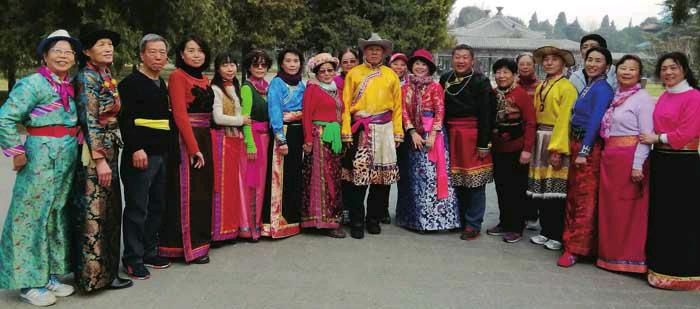The Circle of Happiness
2017-09-12BySudeshnaSarkar
By+Sudeshna+Sarkar
For years, Li Guang taught computer science and management. Then two years before retirement, the burly, affable teacher decided to take a new step. Hes still teaching but no longer at the Yanshan Education Institute for Adults in southwest Beijing and no more computer science either.
Instead, the 62-year-old is teaching guozhuang, a traditional Tibetan dance also known as circle dancing.
Every morning, come rain or shine, Li is out of bed at 5 a.m. to get ready for his class that starts at 7.30 a.m. He chooses the days music with care—recorded Tibetan songs—and accompanied by his wife, Zhang Jian, heads for the nearby sprawling lush green park that is part of one of Beijings most famous tourist attractions, Tiantan or the Temple of Heaven.
When the Temple of Heaven was built in the 15th century for Emperor Yongle of the Ming Dynasty (1368-1644) to pray in splendor to the gods in the hope of a bountiful harvest, Tiantan Park was out of bounds for commoners. But now, anyone can stroll in after paying 15 yuan ($2.24) for a daily ticket.
Lis growing group of dancers all have the yearly pass for parks in Beijing, for which others have to pay 200 yuan ($30) but they get it for half price since they are mostly retirees like Li. For those who are above 65, admission to the park is free.
A new dimension
“Its a strange thing,” Li said. “In Tibetan communities, young people, mostly males, do the guozhuang. But in Beijing, where there are not many Tibetans and the dance is performed by retired people, most of whom are women.”
The little party enters Tiantan Park through its four gates and a 10-minute brisk walk along the rose bushes takes them to the spot they have marked as their own, a large circular area with leafy trees and plenty of benches. A cloth is spread at the foot of a tall tree where the dancers, who are mostly women, deposit their bags. Then they take out their dance costumes—Tibetan wraparound skirts with an embroidered border and sashes to be tied at the waist.
Some opt for the long fl owing tunic called the baku or chuba, which is topped off by colorful headdresses and chunky jewelry.
Then the music starts and the dancing begins. The students dance in a circle, keeping a watchful eye on Li, who, resplendent in his short skirt and cowboy-like hat, shows the steps with effortless fi nesse while belting out instructions in time with the music.endprint
The foot-tapping beats and the striking costumes are irresistible. Other park-goers stop their jogging or taichi to look. White-haired elders who have come for their morning constitutional lower themselves on the benches gratefully and watch while passersby fish out their phones to take photos or videos.
Originally, the guozhuang was a piece of stone used to support an iron pan or copper pot on a fi re. Since people kept moving around the fi re, thats how the dance got its name. In 2006, the State Council, Chinas cabinet, approved the inclusion of the dance in the national intangible cultural heritage directory.
Lis guozhuang adventure started eight years ago when he walked into the park one day and came upon a group dancing to an unfamiliar but fascinating music. “The music is amazing,” he said. “It is a window to Tibetan culture. The dance is performed during festivals and religious ceremonies when the entire community joins in. Since its meant to be danced in a circle, the more people there are, the merrier.”
The master leading the group was a retiree, Wang Jianlin, who came from Qinghai Province in the northwest, where he had learned the dance. Li became part of the group and later, decided to spread his wings and form his own troupe.
In 2013, loyally accompanied by his wife and three close friends, he began his dance classes in the Yanshan institute, where some of his student s joined in, but two years later, moved to Tiantan Park since it was closer to home.
Today, there are about 50 dancers in the group. While the youngest would be in their 40s, the oldest is 77. “We welcome everyone to join,” said Kong Rui, a software developerturned-journalist whom Li has dubbed his best and ablest dancer. “We also have foreign tourists passing through the park joining us. We welcome that because music and dance have no boundary.” Since Kong speaks fluent English, she is the groups main interpreter.
Li doesnt charge anything for the classes.“I have my pension,” he said. “I dont want to make money from teaching guozhuang. What I would like to do is to attract more people, make the team bigger and take the dancing to a higher level.”
He dismisses foreign media reports that try to highlight rifts between Han Chinese and Tibetan Chinese. He and his group are all Han Chinese.
“We are not interested in politics,” he said.“We are only interested in the music and dancing. We want to help people understand Tibetan culture so that there is better understanding and harmony.”endprint
A novel culture map There is something almost predestined about his objective. When Li was 15, due to the “cultural revolution” (1966-76), he and his family had to leave Beijing and move to Gansu, a province in the northwest close to an area with a large Tibetan population.
He was luckier than many others and was able to study at the Lanzhou Science and Technology Institute. It was also in Gansu that he met his wife.
When they were 40 and the impact of the“cultural revolution” was over, they came back to Beijing as “talent imports.”
Now his plan to contribute to the national culture repository is to draw a guozhuang map.“There are 15 to 20 other guozhuang teams scattered in Beijing alone,” he said. “Besides, there are teams in other places like Shanghai, Sichuan and Gansu provinces and Tibet Autonomous Region. We want to create a database where all the groups and their information will be listed so that when a guozhuang dancer from one city goes to another city, he or she will always fi nd friends in a new place.”
As a fi rst step toward that, his group started getting in touch with other teams in Beijing, sharing dancers and ideas. Then in June, the second stage started when the team went on a 15-day tour of Qinghai-Tibet Plateau to identify more groups and learn more local dances.
“At times we stopped in public places and gave impromptu performances,” Kong said. “The result was gratifying. Local people would watch us and clap and some would join in. At such a show on our way from Lhasa to Nyingchi City of Tibet, the local vendors gave us fruits and water and refused to take money. One seller gave free pancakes to Li, saying he was the best!”
Li has been interviewed by local TV channels and the group posts videos on online platform Youku ahead of their programs to spread the word. They are also working on creating a circle on the popular social media app WeChat to draw more dancers and spread awareness about guozhuang.
To Li and his dancers, guozhuang is not just a dance. They say it has health benefits, both physical and mental.
Meditation on the move
“Its a good way to keep fi t,” he said. “I lost 10 kg and my blood pressure improved.”
According to Liu Qian, Wang Jianqiang and Qin Yinan from the College of Arts and Sports at Sichuan Agricultural University, guozhuang stretches across arts, sports and education.
In their article on guozhuang in the Asian Social Science magazine, they said: “[It] integrates body exercise, dance and music and retains deep Chinese-Tibetan features and local fl avor.”
With many modern sports today requiring a high degree of aesthetics, such as artistic gymnastics and figure skating, they are advocating the inclusion of guozhuang in school curriculums.
“Guozhuang originated from religious ceremonies,” Li added. “It purifies your mind like meditation and makes you calm in your heart, so that you fi nd peace in your mind.”endprint
